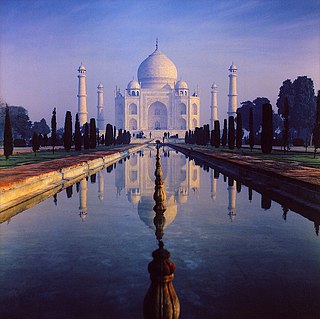The ASI has recognized 366 Monuments of National Importance in Lucknow circle of Uttar Pradesh. [1] For technical reasons, this list of Archaeological Survey of India recognized monuments in the Lucknow circle has been split into three lists:

The Archaeological Survey of India (ASI) is an Indian government agency attached to the Ministry of Culture that is responsible for archaeological research and the conservation and preservation of cultural historical monuments in the country. It was founded in 1861 by Alexander Cunningham who also became its first Director-General.

Kulpahar is a city in Mahoba district in the Indian state of Uttar Pradesh. It is a historical town in the Bundelkhand region. Before 11 Feb 1995 Kulpahar was a Tehsil of Hamirpur District. On 11 Feb 1995 Mahoba District was carved out of Hamirpur, and Kulpahar is now a part of the Mahoba District. Kulpahar is the largest Subdivision of Uttar Pradesh. Kulpahar is known for its closeness to Khajuraho and other historic places like Mahoba, Charkhari, Kalinjar Rath, Orchha, and Jhansi. This town holds relics of temples and man-made water bodies of the Chandela Dynasty

The economy of Uttar Pradesh is the third largest of all the states of India. According to a report published by the Ministry of Statistics and Programme Implementation, Government of India the nominal GDP of the state for the year 2020-21 is ₹17.05 trillion (US$230 billion). The largest Indian state, Maharashtra based on nominal GDP, has an urban population of 5,08,18,259, while Uttar Pradesh has an urban population of 4,44,95,063. According to the 2011 census report, 22.76% of Uttar Pradesh's population lives in urban areas. The state has 7 cities with populations exceeding 10 lakh each. After partition in 2000, the new Uttar Pradesh state produces about 92% of the economic output of the old Uttar Pradesh state. According to Planning Commission estimates for the year 2011-12, 29.4% of the state's total population was poor. However, updated findings by NITI Aayog based on NFHS-4 (2015-16), 37.79% of the population was found to be poor.

The Culture of Uttar Pradesh is an Indian culture which has its roots in Hindi and Urdu literature, music, fine arts, drama and cinema. Lucknow, the capital of Uttar Pradesh, has historical monuments including Bara Imambara and Chhota Imambara, and has preserved the damaged complex of the Oudh-period British Resident's quarters, which are being restored.

Situated in the northern part of India, bordering with the capital of India New Delhi, Uttar Pradesh is one of the most popular and an established tourist destination for both Indians and non-Indians alike in India. The most populous state of India, Uttar Pradesh contains many historical monuments and places of religious significance. Geographically, Uttar Pradesh is very diverse, with Himalayan foothills in the extreme north and the Gangetic Plain in the centre. It is also home of India's most visited sites, the Taj Mahal, and Hinduism's holiest city, Varanasi. Kumbh city, Prayagraj. Kathak, one of the eight forms of Indian classical dances, originated from Uttar Pradesh. Uttar Pradesh is at the heart of India, hence it is also known as The Heartland of India. Cuisine of Uttar Pradesh like Awadhi cuisine, Mughlai cuisine, Kumauni cuisine are very famous not only in India but also many places abroad and Pratapgarh is also famous for Rajputana.

The architecture of Uttar Pradesh demonstrates a diverse and eclectic combination of Buddhist, Hindu, Indo-Islamic, and Indo-European architectural styles. Three of its architectural monuments—the Taj Mahal, the Agra Fort, as well as the township of Fatehpur Sikri founded by the Mughal emperor Akbar—are designated UNESCO World Heritage Sites. The architectural structures in Uttar Pradesh include ancient Buddhist stūpas and vihāras, ancient Buddhist and Hindu monasteries, townships, forts, palaces, temples, mosques, mausoleums, memorials, and other community structures. Uttar Pradesh's architectural structures also include various Hindu temples, Ghats, etc. largely found in ancient cities like Benares (Varanasi), Brindaban (Vrindavan), Mathura, and Prayagraj (Allahabad).